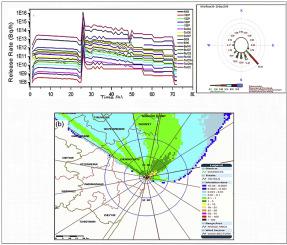当前位置:
X-MOL 学术
›
Prog. Nucl. Energy
›
论文详情
Our official English website, www.x-mol.net, welcomes your
feedback! (Note: you will need to create a separate account there.)
Radiological consequence assessments using time-varying source terms in ONERS- decision support system for nuclear emergency response
Progress in Nuclear Energy ( IF 3.3 ) Pub Date : 2020-09-01 , DOI: 10.1016/j.pnucene.2020.103436 S.S. Raja Shekhar , C. Venkata Srinivas , P.T. Rakesh , R. Venkatesan , B. Venkatraman
Progress in Nuclear Energy ( IF 3.3 ) Pub Date : 2020-09-01 , DOI: 10.1016/j.pnucene.2020.103436 S.S. Raja Shekhar , C. Venkata Srinivas , P.T. Rakesh , R. Venkatesan , B. Venkatraman

|
Abstract Online Nuclear Emergency Response System (ONERS) is a Decision Support System (DSS) developed for the management of Off-Site Nuclear Emergencies for Nuclear Power Plant sites of India. In this work, ONERS is incorporated with a module ‘Time-Dependent Source term (TDS)' for real-time online plume dispersion and radiological consequence assessments using time-varying source terms which is likely during an accidental release. TDS facilitates online dispersion and dose calculations by initiating the FLEXPART particle dispersion model with WRF predicted real-time meteorological forecasts and inputs on hourly release rates of 25 significant radionuclides of both ground level and elevated releases for any reactor accident over a 72-h meteorological forecast domain. The TDS is tested against the existing uniform source term approach for a hypothetical accident for two types of frequent weather conditions over Kalpakkam nuclear site in southern India. Simulations for a complex weather condition (monsoon & local sea breeze) during 26–29 September 2019 indicate that though the simulated plume area is similar in both the cases, the area affected is different as governed by the meteorological condition during the period of releases. It is found that the area and direction of potentially affected zone is determined by most frequent wind flow in the case of uniform source term and the flow direction during the period of maximum release in the case of time-dependent source term. Simulations for winter weather condition during 10–13 January 2020 with nearly uniform flow indicate similar results in both uniform and time-varying release cases. Results indicate that while the time-dependent source terms provide more realistic projection of radiological impact under complex meteorological conditions over uniform source term, both approaches would nearly converge when the maximum release occurs under the most frequent windflow condition. The two approaches are complementary to each other for response actions given the requirements of rapid assessments with gross source terms in the initial phases and more refined assessments with detailed source terms in the later phases of emergencies.
中文翻译:

在ONERS-核应急响应决策支持系统中使用时变源项进行放射后果评估
摘要 在线核应急响应系统(ONERS)是一种决策支持系统(DSS),用于管理印度核电厂场址的场外核应急。在这项工作中,ONERS 与一个模块“时间相关源项 (TDS)”相结合,用于使用可能在意外释放期间随时间变化的源项进行实时在线羽流扩散和放射学后果评估。TDS 启动 FLEXPART 粒子扩散模型,其中包含 WRF 预测的实时气象预报以及 72 小时气象预报中任何反应堆事故的地面和高架释放的 25 种重要放射性核素的每小时释放率输入,从而促进在线扩散和剂量计算领域。针对印度南部 Kalpakkam 核电站上两种频繁天气条件的假设事故,TDS 针对现有的统一源项方法进行了测试。对 2019 年 9 月 26 日至 29 日期间复杂天气条件(季风和当地海风)的模拟表明,虽然两种情况下模拟的羽流面积相似,但受影响的面积因释放期间的气象条件而异。研究发现,在源项均匀的情况下,潜在影响区的面积和方向由最频繁的风流决定,而在时变源项的情况下,最大释放期间的流向决定了潜在影响区的面积和方向。对 2020 年 1 月 10 日至 13 日期间具有几乎均匀流量的冬季天气条件的模拟表明,在均匀和随时间变化的释放情况下,结果相似。结果表明,虽然与时间相关的源项在复杂气象条件下提供了比统一源项更真实的辐射影响预测,但当最大释放发生在最频繁的风流条件下时,两种方法几乎会收敛。考虑到在紧急情况的初始阶段使用总源项进行快速评估以及在紧急情况的后期阶段使用详细源项进行更精细的评估,这两种方法在响应行动中相互补充。结果表明,虽然与时间相关的源项在复杂气象条件下提供了比统一源项更真实的辐射影响预测,但当最大释放发生在最频繁的风流条件下时,两种方法几乎会收敛。考虑到在紧急情况的初始阶段使用总源项进行快速评估以及在紧急情况的后期阶段使用详细源项进行更精细的评估,这两种方法在响应行动中互为补充。结果表明,虽然与时间相关的源项在复杂气象条件下提供了比统一源项更真实的辐射影响预测,但当最大释放发生在最频繁的风流条件下时,两种方法几乎会收敛。考虑到在紧急情况的初始阶段使用总源项进行快速评估以及在紧急情况的后期阶段使用详细源项进行更精细的评估,这两种方法在响应行动中互为补充。
更新日期:2020-09-01
中文翻译:

在ONERS-核应急响应决策支持系统中使用时变源项进行放射后果评估
摘要 在线核应急响应系统(ONERS)是一种决策支持系统(DSS),用于管理印度核电厂场址的场外核应急。在这项工作中,ONERS 与一个模块“时间相关源项 (TDS)”相结合,用于使用可能在意外释放期间随时间变化的源项进行实时在线羽流扩散和放射学后果评估。TDS 启动 FLEXPART 粒子扩散模型,其中包含 WRF 预测的实时气象预报以及 72 小时气象预报中任何反应堆事故的地面和高架释放的 25 种重要放射性核素的每小时释放率输入,从而促进在线扩散和剂量计算领域。针对印度南部 Kalpakkam 核电站上两种频繁天气条件的假设事故,TDS 针对现有的统一源项方法进行了测试。对 2019 年 9 月 26 日至 29 日期间复杂天气条件(季风和当地海风)的模拟表明,虽然两种情况下模拟的羽流面积相似,但受影响的面积因释放期间的气象条件而异。研究发现,在源项均匀的情况下,潜在影响区的面积和方向由最频繁的风流决定,而在时变源项的情况下,最大释放期间的流向决定了潜在影响区的面积和方向。对 2020 年 1 月 10 日至 13 日期间具有几乎均匀流量的冬季天气条件的模拟表明,在均匀和随时间变化的释放情况下,结果相似。结果表明,虽然与时间相关的源项在复杂气象条件下提供了比统一源项更真实的辐射影响预测,但当最大释放发生在最频繁的风流条件下时,两种方法几乎会收敛。考虑到在紧急情况的初始阶段使用总源项进行快速评估以及在紧急情况的后期阶段使用详细源项进行更精细的评估,这两种方法在响应行动中相互补充。结果表明,虽然与时间相关的源项在复杂气象条件下提供了比统一源项更真实的辐射影响预测,但当最大释放发生在最频繁的风流条件下时,两种方法几乎会收敛。考虑到在紧急情况的初始阶段使用总源项进行快速评估以及在紧急情况的后期阶段使用详细源项进行更精细的评估,这两种方法在响应行动中互为补充。结果表明,虽然与时间相关的源项在复杂气象条件下提供了比统一源项更真实的辐射影响预测,但当最大释放发生在最频繁的风流条件下时,两种方法几乎会收敛。考虑到在紧急情况的初始阶段使用总源项进行快速评估以及在紧急情况的后期阶段使用详细源项进行更精细的评估,这两种方法在响应行动中互为补充。











































 京公网安备 11010802027423号
京公网安备 11010802027423号